
Although today’s business environment is clearly very challenging, there are still many opportunities to make a difference with technology. How can you maximise the chances of success, and organise your activities such that the uptake of technology is accelerated, even in today’s environment?
In this blog, we will reveal a few secrets to boost your technology with the Tech Positioning Programme, based on >20 years of technology deployment experience.
This programme helps you to identify strengths and opportunities to improve the overall offering to make it as attractive as possible to the broadest appropriate customer base.
Tech Positioning: what is it all about?
With the Tech Positioning Programme, we help you to understand the Impact versus Do-ability of a technology, taking into account the environment in which the target customer operates. Technology is assessed against criteria grouped under 7 themes, through a structured dialogue with key stakeholders. The Tech Positioning Programme provides key insights into the reasons why a technology is difficult or relatively easy to deploy. Also, based on the outcome of the Tech Positioning Programme, specific actions can be defined to increase the chances of success. Our experience is that most challenges for getting technology deployed are non-technical, and the Tech Positioning Programme reflects that.
So what are the 7 themes of the programme? Let’s go through them, one by one.
THEME 1 - (PERCEIVED) BUSINESS IMPACT
The first theme may sound trivial and easy, but actually it is not. It is important to make a realistic assessment of the impact in terms of cost reduction, production (or uptime) enhancement, safety exposure reduction, CO2 emission reduction or potentially other business performance indicators. This will then have to be presented to the appropriate person in the customer organization. The customer will only buy into the solution if they believe the business impact numbers.
As part of the structured dialogue, we will explore whether the right person is targeted. Is this really the person who has the most interest in the technology? Should you go one level down in the organisation (such that the business impact is of sufficient interest to the person you’re targeting), with the risk that the person has less authority to make decisions? Or should you go a level up, with the risk that the technology is of relatively less importance, and the risk that the person one level up can devote less time given the many other responsibilities that he/she has? Does the person you’re targeting only have decision authority in a local organisation, or does the person have the authority to take decisions for deployment globally? These and other points will come up as part of the dialogue.
Part of this theme also is: are you presenting the technology in the right way, such that it resonates with the person you’re talking to? Should you change your pitch? If your messages are not right, the impact of the technology may be perceived as being lower than it actually is.
THEME 2 - BUSINESS IMPACT DIMENSIONS
Typically the most attractive technologies are those that reduce cost AND increase production (or uptime) AND improve Health/Safety/Environment. Not only compared to conventional solutions, but also compared to alternative solutions available on the market.
Naturally, not all technologies will positively impact all these three elements. If technology scores negative against one of those elements, then you can be sure that you will encounter resistance: from the people who own the performance indicator that is negatively impacted. It essentially means that you need to target a person one or more levels higher in the organisation, the person that owns all relevant performance indicators.
Determining the person to whom you need to sell the idea is largely driven by Theme 2, in combination with 1.
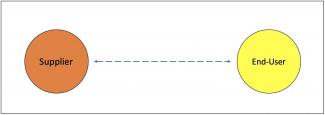
Do you have a trustful relationship with the person that you’re targeting?
A key question you then need to ask yourself: do you know this person, and do you have a trustful relationship with the person? If not, then you can, of course, try to develop such a relationship, but this takes time. It can be more effective to work through someone else; a person you as well as the target customer have a trustful relationship with!

Often more effective: instead of building new relationships, work through others
It’s also important to understand the ‘movers’ and ‘shakers’ around the decision-maker and feed those people with the right messages. Getting acceptance for your technology is very much an influencing game!

It helps if people hear about technologies from different angles (in addition to what they hear from the technology supplier)
THEME 3 - RISK & REWARD BALANCE
There are many examples of technologies where one part of the organization gets the rewards, while another runs the risk. Or technologies that help the operator and eat into the profit of suppliers. The more a-symmetric the risk/reward profile, the more resistance you may experience. The best technologies are truly win-win for all parties involved. If it is not, then it is at least important to be fully aware, such that you can address the imbalance as much as possible.
Very often the reasons why technology deployments get stuck are related to this theme, hence important to have a very good discussion around it. If you don’t, you may find forces at work that openly or quietly block the deployment. The key is to create a winning team.
To illustrate the above a bit further: there are many technologies that can improve maintenance activities. In order to introduce these technologies, providers often have to work through maintenance contractors to get those to the end-user. Do these maintenance contractors have the incentives to introduce the innovations? Or would they not do it, because it reduces their revenue? Is it more attractive for them to promote conventional solutions?
And how to handle the introduction of the technology that will result in job losses? How can you still introduce such technologies while managing the resistance that you may encounter? Fortunately, there are various ways on how such a situation can be handled.
THEME 4 - CHANGE MANAGEMENT REQUIREMENTS
Under this theme, technology is assessed against specific change management aspects that are relevant for getting technology deployed. The more complex the change, the more change management that will be required. The less change, the smoother the deployment will go.
As part of this theme, a quality discussion takes place around how much change is needed to introduce the technology, and what actions need to be taken to make the change as smooth as possible. If the amount of change is (perceived to be) too significant, then people may prefer to focus on other things they can do to improve the business.
THEME 5 - DEPLOYMENT REFERENCES
It is often said that the Oil & Energy industry is conservative, and there is a degree of truth in it. In all fairness though, it is understandable that people don’t want to unnecessarily experiment with new approaches to put humans, production, environment, reputation or careers at risk. The quickest wins can be realized by deploying technology successfully used or assessed by others. And usually, the ‘closer’ the other user, the more convincing the deployment reference will be. Like in our daily life.
Although many technology users tend to believe that their business situation is unique; it hardly ever is. There are almost always analogues. Even if the specific technology may be novel, it usually contains underlying components that have been proven already elsewhere.
Actions related to this theme very often are that we link up a potential user in one company with an independent expert who has experience with the technology already (or with technology of similar nature), such as an independent expert who has written a review for a technology on TechnologyCatalogue.com. Nothing helps more than such direct conversations, and we can use our network and experience to connect you with the right people, and facilitate an exchange.
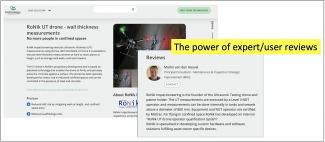
The power of a review from an independent expert
THEME 6 - TECHNICAL DO-ABILITY
The themes discussed so far were mostly non-technical. But obviously the technology has to be technically sound. These aspects are covered under this theme. Under this theme, we have a dialogue around questions such as the following:
-
Are the product specifications supported by evidence?
-
Is the technology suitable for the specific application?
-
Do in-depth technical review/studies confirm the applicability?
-
Is the technology in line with industry standards?
-
Does the technology have explicit support from the relevant expert?
-
Is his/her opinion (widely) known and do you make use of the review when promoting the technology? Is the view accepted by the end-users?
-
Does the user have the capability and know-how to support the technology deployment and to sustainably embed the technology?
THEME 7 - PROCUREMENT AND SUPPLY CHAIN
Last, but certainly not least! Under this theme, a structured dialogue takes place around specific questions related to Procurement and Supply Chain.
Like with the previous themes, it is important to have an in-depth dialogue that results in a clear picture on the deployment path with the least resistance.
To illustrate with a practical example: we once were involved in the deployment of a novel scaffolding technology. This scaffolding technology was developed by a small company, and delivered to the end-user through a large maintenance contractor. Following the first successful deployment, the target customers for deployments 2 and 3 were simply determined by asking the question: where else can this technology be deployed through the same maintenance contractor? Can it be delivered through existing contracts already in place, leveraging existing relationships?
The outcome of the Tech Positioning Programme
The outcome of the Tech Positioning Programme is visualized with a spider diagram and a matrix. The spider diagram visually shows what the score is for the various themes: the % of points scored considering the maximum number of points that can be scored. It immediately gives an indication where the weakest link(s) are.
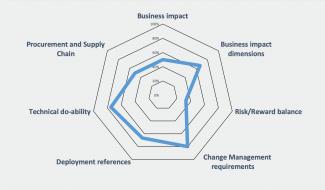
The outcome can also be translated into an Impact versus Do-ability matrix. The Impact axis gives the % of points achieved for themes 1 and 2, and the Do-ability axis gives the % of the points gained on the other 5 themes.
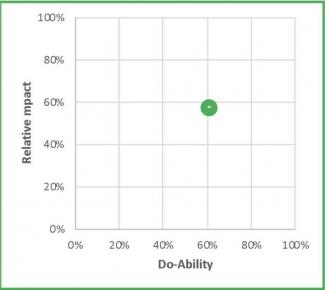
Outcome of the Tech Positioning Programme using an Impact versus Do-ability Matrix
Prioritising your customers
The matrix is particularly useful when showing the status of your technology for different customers. This way you make it visible which customers to target first, whereby the outcome of the Tech Positioning Programme will help you with the specific actions you need to take to target the customer.
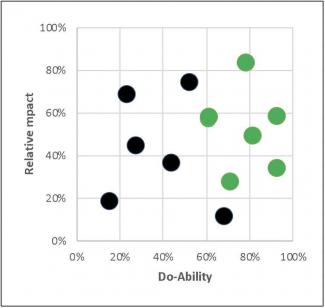
Analysing the Impact versus Do-Ability matrix for different customers
Conclusion
Although today’s business environment is clearly very challenging, there are many opportunities to make a difference with technology… provided you position your technology for success! Curious how this can help you? Please contact us at info@technologycatalogue.com!
About us
The founders of TechnologyCatalogue.com led technology deployment activities in support of assets across Shell. Over 600 deployments were successfully delivered, resulting in a very significant impact on safety, production and cost. We understand what it takes to get technology deployed, including all change management aspects related to it. Since starting TechnologyCatalogue.com in March 2018, we have supported multiple operators in Upstream and Downstream with technology deployment.
Our platform TechnologyCatalogue.com was developed based on the first-hand experience that it is often difficult for decision-makers to stay up to date on available technology-driven improvement opportunities for their business. It was launched in Q3 2018 and is steadily growing in terms of content & functionality. Since the launch, >24,000 unique users have accessed the platform. We’re also developing customised versions of the platform. For example, jointly with National Energy Resources Australia, we have delivered a customised version of the portal for Australia (Nera.TechnologyCatalogue.com)
In addition to TechnologyCatalogue.com, we also support suppliers and end-users with getting technology deployment done, through consultancy & workshops.
